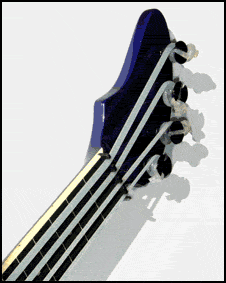| Ashbory Bass Tour by Brock Frazier | << Back Next >> |
Part two: A closer look.
 |
| Standard sized electric bass guitar compared to an Ashbory |
Something about the Ashbory that becomes very obvious from the first look is how small it is. With a scale length only one inch over half of a standard bass guitar (18 inches for the Ashbory, 34 inches for a Fender-style bass guitar) it is certainly understandable why people sometimes will initially dismiss it as a toy. This is a mistake, as the Ashbory is wonderful instrument, and in the right hands, a very powerful tool. For comparison, a violin has a scale length of about 13 inches.
The key components of the Ashbory are the pickup/bridge, strings, body/neck, fingerboard, and the tuners. We'll start with the things that create the unique sound of the Ashbory, which are the pickup system and bridge, and the strings.
Pickup/Bridge: The Ashbory bridge is a special bridge with an integrated piezo saddle pickup system. The bridge is not adjustable, and is designed specifically for the use of the silicon rubber strings. The piezo transducer element is not completely unlike what one might find in an acoustic/electric guitar. There is no standard magnetic field pickup in an Ashbory, which is a good thing since the non-metallic strings would have no effect on such a pickup.
 |
| Silicone rubber strings, printed lined fretless fingerboard, and special tuners are all unique Ashbory features. |
Strings: The strings are made of solid silicone rubber. They have a warm, deep sound which is picked up by the piezo transducer. It is the strings which create the distinctive Ashbory tone. Faltering creates warmth in the tone of any instruments, and with the Ashbory the faltering occurs mostly in the strings as opposed to body and neck of a bass guitar or upright bass. They also make up a higher percentage of the instrument's tone compared to a standard electric bass guitar. The strings are also low tension compared to their metal bass guitar and upright bass counterparts.
Body/Neck: The body and neck is one piece of wood, with no truss rod for added neck rigidity. Why? Since the silicone strings are lower tension and short scale, there is no need for a large instrument body or any additional reinforcement. The small size makes the Ashbory Bass very portable and easy on the back, less than 3 pound total weight.
Fingerboard: The fingerboard is a printed piece of plastic with 'fret lines'. The fret lines are there to give a reference to where notes are on the neck. As with any fretless instrument, it is up to the player to adjust their fingers to achieve good intonation.
Tuners: The tuners on the DeArmond Ashbory are open geared units designed for Ashbory use. They are much more convenient to use than the friction peg design that was used on the original Guild models.
Electronics: The Ashbory features an active electronics system with three control knobs. The bass and treble knobs are notched at 5 for convenient add/subtract operation, and the volume knob is exactly that, a simple volume control. The active system is activated and deactivated by plugging and unplugging the standard 1/4 inch instrument cable. The circuity is powered by a standard 9 volt battery.
The physical form of the Ashbory is much smaller and more simple than an upright bass or electric bass guitar, but is has a more complex than average electronics configuration to deliver world-class bass sound from a compact package.
| << Back Next >> |
